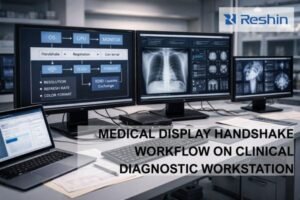Medical displays are mainly used in hospital departments such as radiology, operating rooms, endoscopy, pathology, emergency, and dentistry. With the rapid development of medical technology, medical displays are becoming more and more widely used in modern hospitals.
As high-precision, high-resolution, and high-color-accuracy professional display devices, medical displays have become important tools in many departments. Different departments have different needs for display devices. Therefore, medical displays vary in functions, performance, and application scenarios.
Next, let’s explore the applications and importance of medical displays in different hospital departments.
1: Imaging (Radiology) – the key to accurate imaging diagnosis
The radiology department is one of the main areas where medical displays are widely used. It is mainly for viewing and diagnosing medical images, such as X-ray, CT, MRI (Magnetic Resonance Imaging), mammography, and ultrasound.
So, what are the requirements for displays in these medical imaging devices?
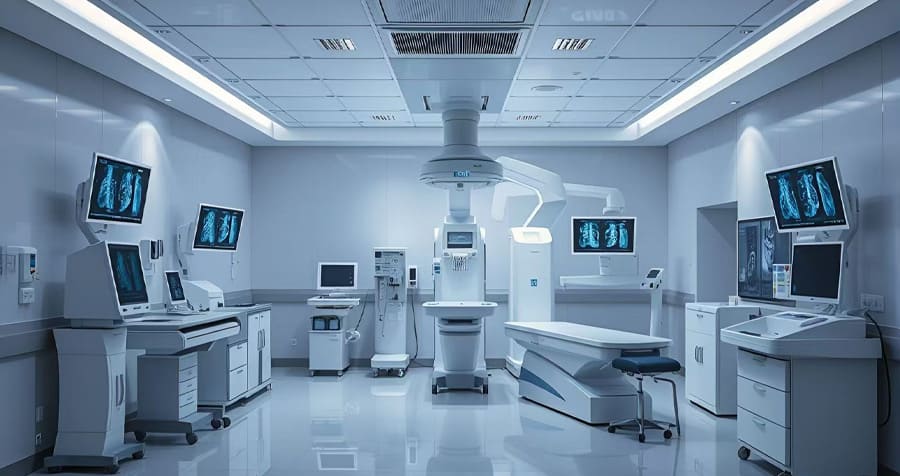
1.1 high resolution
CT, MRI, and X-ray images contain a lot of details, so high-resolution displays are needed to make sure everything is clear. Usually, 2MP, 3MP, 4MP, or higher resolution displays are required to show clear image layers and improve diagnosis efficiency.For mammography, 5MP or higher resolution displays are needed to accurately detect small lesions.
1.2 DICOM Standard Support
Displays that meet the DICOM standard can ensure that medical images are shown with accurate grayscale and precise contrast.
1.3 High brightness and stable color performance
Meeting the needs of doctors for long-time image reading, reducing eye fatigue from extended viewing, and improving diagnosis efficiency.
2:Operating Room (Surgery) – An Essential Tool for Precise Surgical Navigation
The operating room requires medical equipment to be highly reliable and very clear. Medical displays play a very important role here.
In laparoscopic or endoscopic surgery, doctors rely on high-resolution medical displays to see the surgical area. 4K and HDR display technology provide higher contrast and more realistic colors, making blood vessels, tissues, and nerves clearer. This helps improve surgical safety.
So, what are the requirements for medical displays in the operating room?
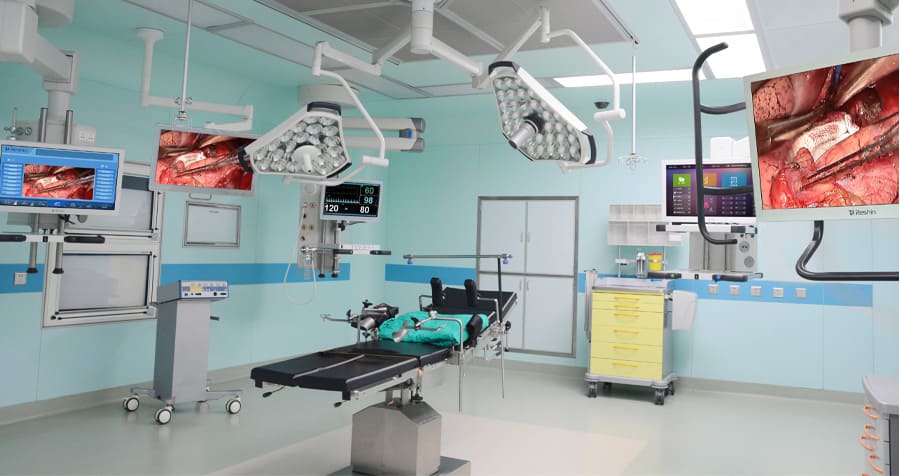
2.1 Ultra HD resolutions 4K and above
Ultra-high resolution ensures that details during surgery are clear, helping doctors perform precise operations.
2.2 Low latency real-time display
In endoscopic and robotic surgeries, image delay can affect the operation. So, medical displays must have ultra-low latency.
2.3 High brightness and anti-reflection performance
Ensure clear display in the bright environment of the operating room without being affected by strong light.
2.4 Waterproof and dustproof design
The operating room has a special environment, so equipment needs a certain level of protection, such as the IP65 standard, to meet disinfection and dustproof requirements.
3:Endoscopy Department: A boost for high-definition minimally invasive diagnosis and treatment
Endoscopy is widely used in gastroenterology, ENT (ear, nose, and throat), urology, and other fields. High-definition medical displays play a very important role.
For example, in gastroscopy and colonoscopy, an HD display can clearly show small lesions on the stomach wall. This helps doctors detect stomach cancer, ulcers, and other diseases earlier, improving diagnosis and treatment.
Now, let’s look at the requirements for medical displays in endoscopy.
3.1 Higher resolution
Higher resolution helps to observe small lesions, such as tiny blood vessels in the stomach lining and polyps.
3.2 High color reproduction
It helps doctors clearly identify diseased tissues and show the true shape of lesions, making future treatment easier.
3.3 high frame rate
Reduce motion blur during operation, ensuring doctors get a clear and stable image while working.
3.4 Anti-blue light, low fatigue
Doctors spend long hours looking at screens every day. Anti-blue light technology can effectively help doctors reduce eye strain and improve work efficiency.
4:Pathology Department – A Powerful Assistant in Digital Pathology Analysis.
The work in the Pathology Department mainly involves the analysis of tissue slices. Traditionally, this relied on microscope observation. However, nowadays, digital pathology microscopes combined with high-resolution medical displays have become a new trend in modern pathology diagnosis. Next, let’s take a look at what kind of display our Pathology Department should use.
4.1 ultra high resolution(≥8mp)
Pathology slide images contain a large amount of data and require ultra-high resolution displays to show the fine details.
4.2 Wide color gamut (Adobe RGB or DCI-P3 standard)
Ensure accurate color reproduction, especially the consistency of staining colors in tissues.
4.3 Precise contrast
It helps in identifying cell structures and diseased areas, improving diagnostic accuracy. In tumor pathology analysis, high-definition pathology displays can assist pathologists in quickly identifying cancer cells, enhancing the efficiency of pathology diagnosis.
5:Emergency Department/ICU——Reliable tool for real-time life detection
The Emergency Department and ICU require real-time monitoring of patients’ vital signs, such as electrocardiogram (ECG), blood oxygen saturation (SpO2), and blood pressure, placing extremely high demands on the stability and visibility of displays. During emergency resuscitation, doctors need to quickly observe changes in patients’ vital signs. Therefore, medical displays with high brightness and high contrast can ensure rapid decision-making in complex environments. So, what requirements should medical displays in the Emergency Department meet?
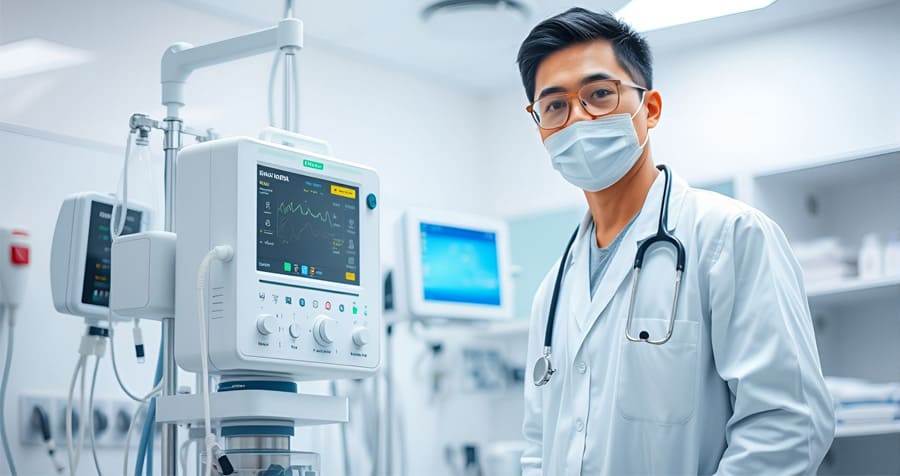
5.1 High-definition display + high contrast
Ensure critical vital signs are clearly visible
5.2 Strong anti-interference ability
In the ICU environment, where there are numerous medical devices, displays must have good electromagnetic compatibility to avoid signal interference.
5.3 Multi-view visibility
Doctors and nurses need to view the screen from different angles, so medical displays should have a wide viewing angle design.
6:Dentistry – High-precision oral diagnosis and treatment
Dental clinics often use 4K displays connected to intraoral cameras to show patients’ teeth conditions in real time, improving patients’ understanding and assisting doctors in developing treatment plans. During dental procedures, doctors need to observe tooth details and display oral conditions to patients, so medical displays also play an important role. So, what requirements should medical displays meet to be suitable for dental use?
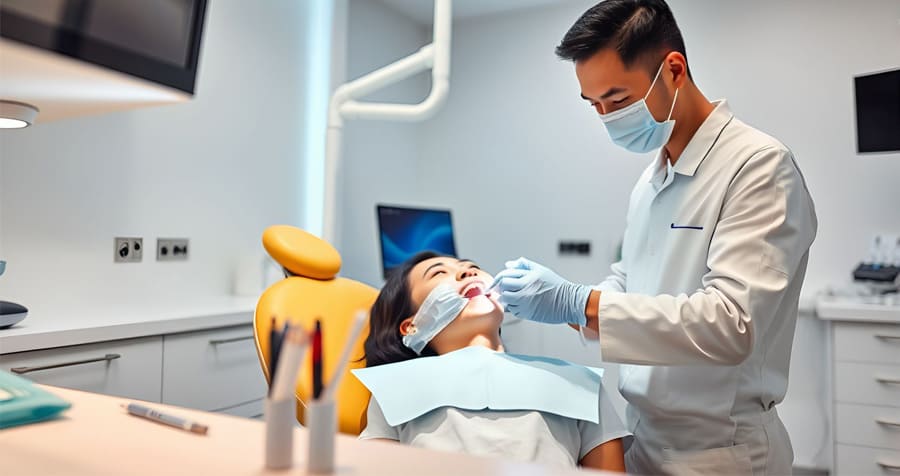
6.1 High resolution (≥4K)
High-resolution displays can clearly show tooth structures, as well as details such as cavities and periodontal lesions.
6.2 High color accuracy
Small changes in tooth color can affect treatment plans, making accurate color reproduction particularly crucial.
6.3 Flexible installation methods
Wall-mounted or rotatable stand designs make it convenient for both doctors and patients to view the display.
Medical displays play an important role in various departments, from imaging diagnosis, surgical navigation, and endoscopic examinations to pathology analysis, emergency monitoring, and dental treatment. They are crucial in improving the quality of diagnosis and treatment, as well as enhancing doctors’ work efficiency. With technological advancements, future medical displays will move towards higher resolution, more accurate color reproduction, and greater intelligence, bringing significant changes to the medical industry.

